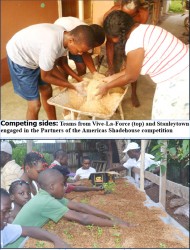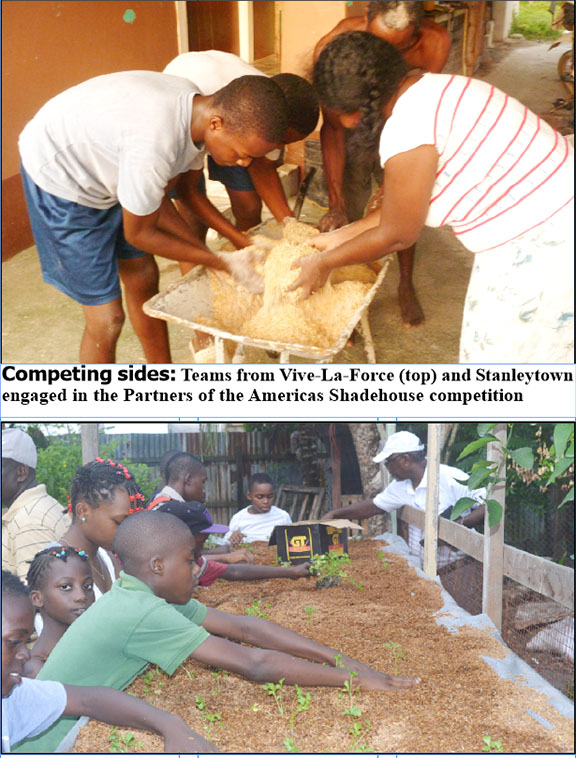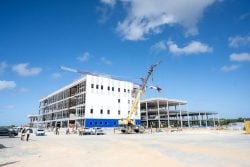Given its focus on targeting poor families in coastal and rural communities seeking to secure sustainable livelihoods, the Partners of the Americas shade house farming initiative has attracted considerable attention across the country.
Its creative application of farming methods provide an important incentive for families to turn to the land.
How to make farming more appealing to children given all of the various other distractions that compete for their attention, bearing in mind that farming can help increase family incomes, is one of the challenges Partners of the Americas appears to have set itself. Earlier this week, Stabroek Business was briefed on a pilot project on the West Coast Demerara designed to make agriculture “a fun activity for children” whilst simultaneously introducing them to agri-business, the pursuit of benefiting from the fruits of their labour. As a means of securing and maintaining the attention of the young farmers the project infused a competitive dimension into the activity. Two communities in Region Three, Vive-La-Force and Stanley-town were targeted for the execution of the project and between 10 and 15 children were selected from each of the two communities. With adults working alongside the children, the groups were exposed to training in natural vegetable production, backyard composting and natural pesticide production. The group associated with the best effort will be awarded a prize.
 Financial constraints within families may have precluded many of the children from acquiring some of the critical material for the production of plant boxes or the acquisition of substrate materials. Ingenuity, however, is one of the qualities which the children are expected to bring to the effort and the Partners of the Americas Secretariat has told Stabroek Business that the limitations notwithstanding, the young participants have indicated their interest in undertaking their own initiatives to secure material assistance in order to take their effort forward. Accord-ingly, project activities currently focus on sourcing and making available to participants basic inputs for taking the initiative forward. The priority pursuits include the acquisition of wooden posts and runners/rafters for the creation of sheds and plant boxes. The Project Secretariat says that the children will also be seeking to source critical materials such as greenhouse plastic, shade cloth, construction plastic, seedlings, paddy shells and hydroponic fertilizers.
Financial constraints within families may have precluded many of the children from acquiring some of the critical material for the production of plant boxes or the acquisition of substrate materials. Ingenuity, however, is one of the qualities which the children are expected to bring to the effort and the Partners of the Americas Secretariat has told Stabroek Business that the limitations notwithstanding, the young participants have indicated their interest in undertaking their own initiatives to secure material assistance in order to take their effort forward. Accord-ingly, project activities currently focus on sourcing and making available to participants basic inputs for taking the initiative forward. The priority pursuits include the acquisition of wooden posts and runners/rafters for the creation of sheds and plant boxes. The Project Secretariat says that the children will also be seeking to source critical materials such as greenhouse plastic, shade cloth, construction plastic, seedlings, paddy shells and hydroponic fertilizers.
For the children one particularly rewarding facet of the project has been their direct involvement in discussions regarding how to acquire some of the material associated with the execution of their assignment. More than that, the project supervision team is pursuing a recommendation that the children, where available, accompany the project supervisor to a rice mill to secure paddy shells.
The project, which commenced last October following consultation with parents, included instruction sessions in the creation of seed boxes. Seedlings were sourced from a newly-constructed nursery at Vive-La-Force and the first set of planting commenced during the second week of December. The Stanleytown community fielded a total of 12 children – nine boys and three girls ranging in ages from 10 to 19. The Vive-La-Force community is represented by 10 children – eight boys and two girls aged between 11 and 15 years old.
Both groups planted lettuce as their first crop, whilst the Stanleytown contingent has also cultivated pak choi. This first round of the competition which was judged by technical staff assigned to the Shade house Project took account of the children’s knowledge of hydroponics, understanding of husbandry and the level of plant growth accomplished. The winners of the competition will be determined at the end of its third and final phase.
Meanwhile, the children and their parents participated in farm tours in Regions Three and Four on January 10; an exercise which afforded them the opportunity to see four established shade houses and to visit the Shade house Project Office and Demonstration Learning Centre at Sophia. The Project Secretariat has reported that one parent has since been inspired to construct a shade house and resume farming activities in preparation for his imminent retirement. 1Stabroek Business has been informed that a prize-giving ceremony will be held in March though the more significant expectation is that the children of Stanleytown and Vive-La-Force will serve as an example to other youngsters in other communities across the country.






